A Case History of Graphite Exploration in North Norway Integrating Various Geophysical Surveys
Abstract
1. Introduction
2. Geological Setting
3. Materials and Methods
3.1. Helicopter-Borne Electromagnetic and Magnetic Method
3.2. Ground Electromagnetic Measurements
3.3. Electrical Resistivity Tomography (ERT) and Induced Polarization (IP)
3.4. Charged-Potential (CP) and Self-Potential (SP) Measurements
3.5. Analytical Methods
3.6. Core Drilling, Sampling, and Analyses
4. Results
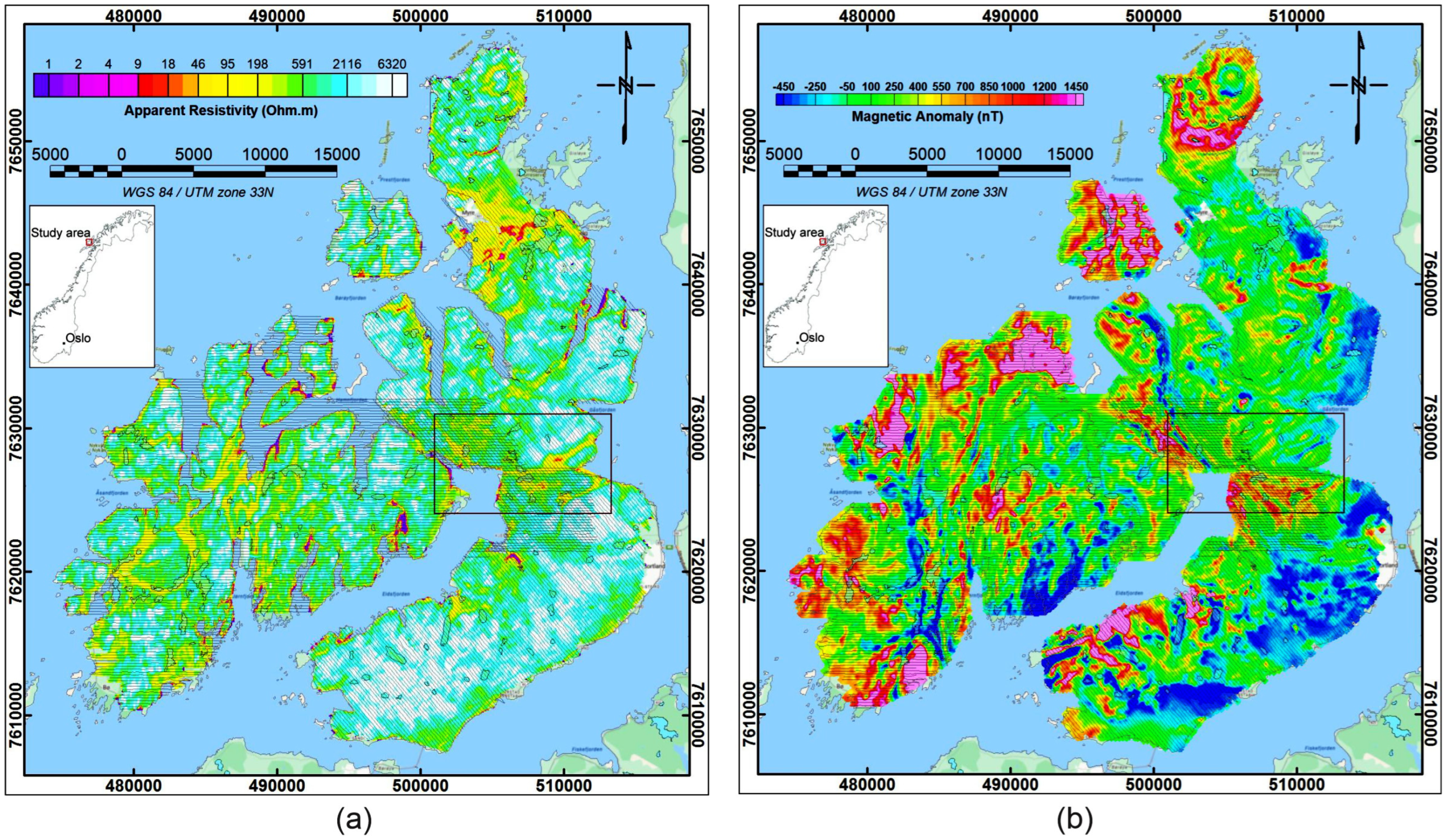
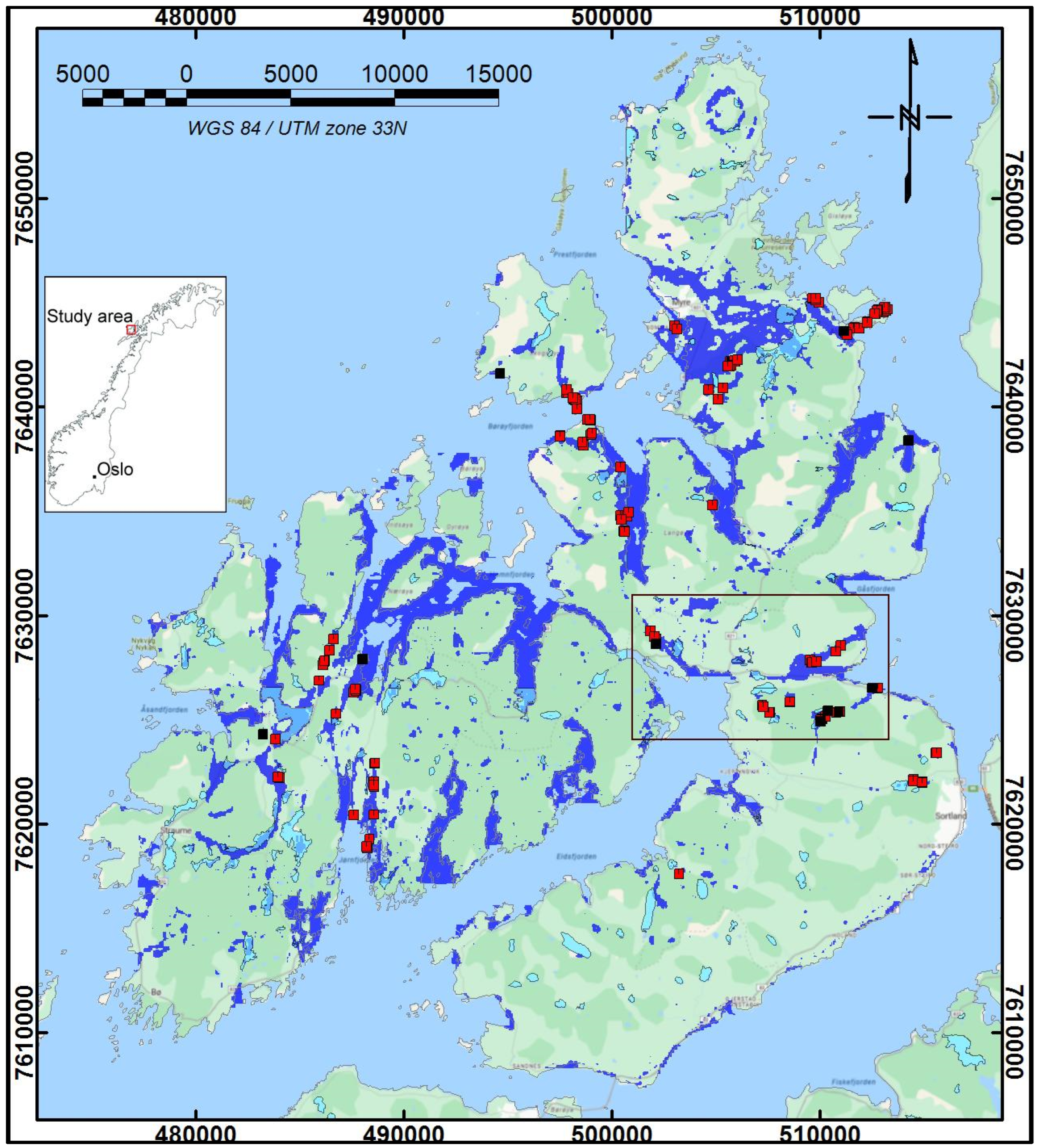
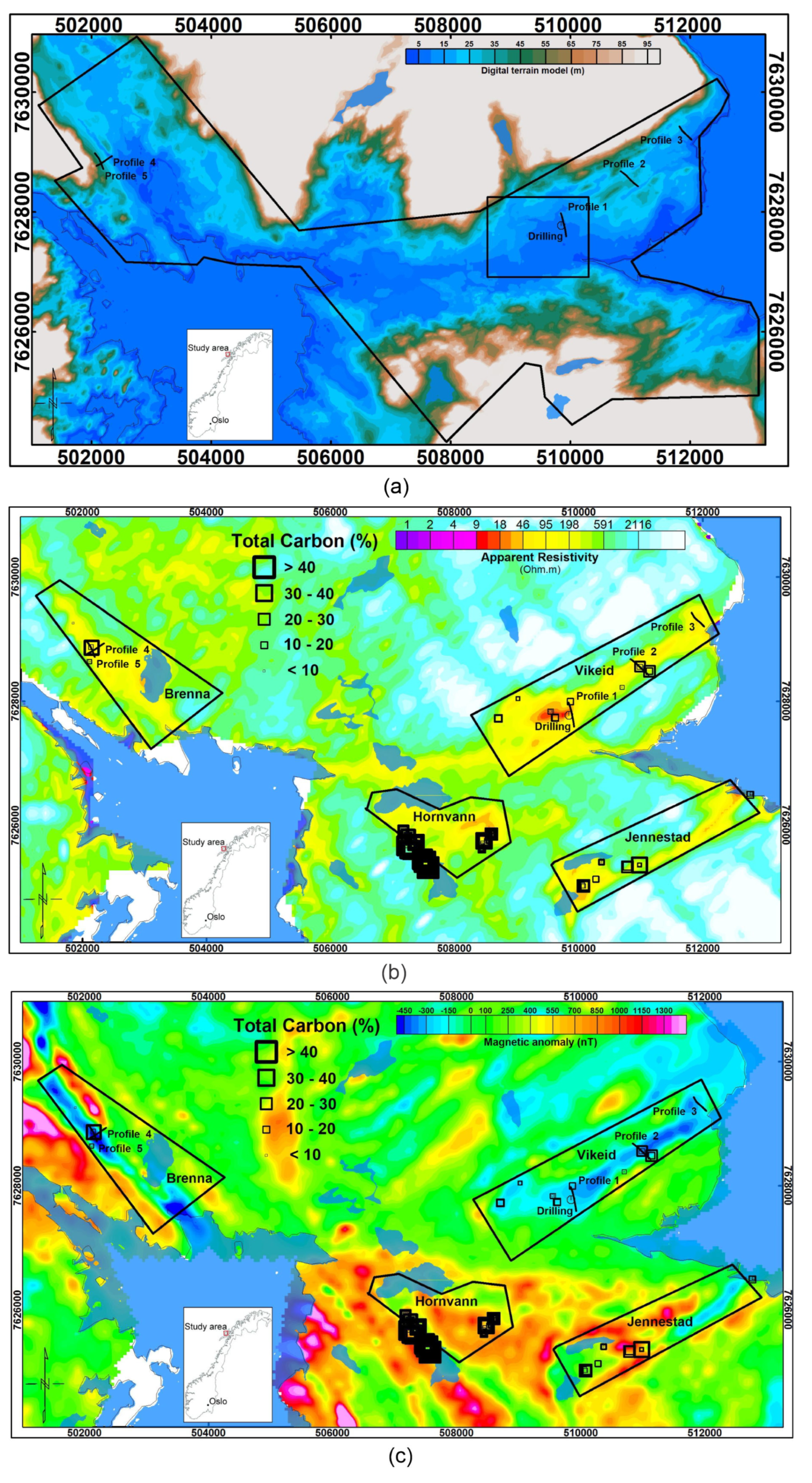
5. Discussion
6. Conclusions
Author Contributions
Funding
Data Availability Statement
Acknowledgments
Conflicts of Interest
References
- Sun, L.; Xu, C.; Xiao, K.; Zhu, Y.; Yan, L. Geological characteristics, metallogenic regularities and the exploration of graphite deposits in China. China Geol. 2018, 1, 425–434. [Google Scholar] [CrossRef]
- Bobba, S.; Carrara, S.; Huisman, J.; Mathieux, F.; Pavel, C.; Carrara, S.; Mancini, L.; Unguru, M.; Blagoeva, D.; Mathieux, F.; et al. Critical Materials for Strategic Technologies and Sectors in the EU—A Foresight Study; Publications Office of the European Union: Luxembourg, 2020; 100p, Available online: https://rmis.jrc.ec.europa.eu/uploads/CRMs_for_Strategic_Technologies_and_Sectors_in_the_EU_2020.pdf (accessed on 19 June 2023).
- IEA. The Role of Critical Minerals in Clean Energy Transitions; Special Report of the World Energy Outlook (WEO); Team of the IEA: Paris, France, 2021; p. 287. Available online: https://www.iea.org/reports/the-role-of-critical-minerals-in-clean-energy-transitions (accessed on 19 June 2023).
- Rønning, J.S.; Gautneb, H.; Larsen, B.E.; Baranval, V.C.; Davidsen, B.; Engvik, A.; Gellein, J.; Knežević, J.; Ofstad, F.; Ren, X.; et al. Geophysical and Geological Investigations of Graphite Occurrences in Vesterålen, Northern Norway, in 2018 and 2019; Geological Survey of Norway Report 2019.031; Geological Survey of Norway: Trondheim, Norway, 2019; pp. 1–212. Available online: https://www.ngu.no/upload/Publikasjoner/Rapporter/2019/2019_031.pdf (accessed on 19 June 2023).
- Engvik, A.K.; Gautneb, H.; Mørkved, P.T.; Solberg, J.K.; Erambert, M. Proterozoic Deep Carbon-Characterisation, Origin and the Role of Fluids during High-Grade Metamorphism of Graphite (Lofoten-Vesterålen Complex, Norway). Minerals 2023, 13, 1279. [Google Scholar] [CrossRef]
- Gautneb, H.; Rønning, J.S.; Larsen, B.E. A step towards meeting battery raw material demand: The geology and exploration of graphite deposits, examples from northern Norway. Geol. Soc. Lond. Spec. Publ. 2022, SP526-2021-180. [Google Scholar] [CrossRef]
- Gautneb, H.; Knežević, J.; Johannesen, N.E.; Wanvik, J.E.; Engvik, A.; Davidsen, B.; Rønning, J.S. Geological and Ore Dressing Investigations of Graphite Occurrences in Bø, Sortland, Hadsel and Øksnes Municipalities, Vesterålen, Nordland County, Northern Norway 2015–2016; NGU Report 2017.015; Geological Survey of Norway: Trondheim, Norway, 2017; pp. 1–70. Available online: https://www.ngu.no/upload/Publikasjoner/Rapporter/2017/2017_015.pdf (accessed on 19 June 2023).
- Neumann, H. Dagbok fra Nord-Norge 26.5-19.8 1952; NGU Rapport Ba 7709; Geological Survey of Norway: Trondheim, Norway, 1952; pp. 1–16.
- Gautneb, H.; Tveten, E. The geology, exploration and characterisation of graphite deposits in the Jennestad area, Vesterålen, northern Norway. Nor. Geol. Undersøkelse Bull. 2000, 436, 67–74. [Google Scholar]
- Mogaard, J.O.; Olesen, O.; Rønning, J.S.; Blokkum, O. Geofysiske Målinger fra Helikopter over Langøya, Vesterålen; NGU Report 88.151; Geological Survey of Norway: Trondheim, Norway, 1988; pp. 1–88.
- Rønning, J.S. CP-og SP-målinger ved Grafittundersøkelser på Vikeid, Sortland Kommune, Nordland; NGU Report 93.018 93.018; Geological Survey of Norway: Trondheim, Norway, 1993; pp. 1–22. Available online: https://www.ngu.no/upload/Publikasjoner/Rapporter/1993/93_018.pdf (accessed on 19 June 2023).
- Rodionov, A.; Ofstad, F.; Stampolidis, A.; Tassis, G. Helicopter-Borne Magnetic, Electromagnetic and Radiometric Geophysical Survey at Langøya in Vesterålen, Nordland; NGU Report 2013.044; Geological Survey of Norway: Trondheim, Norway, 2013; pp. 1–26. Available online: https://www.ngu.no/upload/Publikasjoner/Rapporter/2013/2013_044.pdf (accessed on 19 June 2023).
- Engvik, A.K.; Gautneb, H.; Baranwal, V.C.; Rønning, J.-S.; Solberg, K.J.; Liu, Y.; Austrheim, H. The control of shear-zone development and electric conductivity by graphite in granulite: An example from the Proterozoic Lofoten-Vesterålen Complex of northern Norway. Terra Nova 2021, 33, 529–539. [Google Scholar] [CrossRef]
- Gautneb, H.; Rønning, J.S.; Engvik, A.K.; Henderson, I.H.C.; Larsen, B.E.; Solberg, J.K.; Ofstad, F.; Gellein, J.; Elvebakk, H.; Davidsen, B. The Graphite Occurrences of Northern Norway, a Review of Geology, Geophysics, and Resources. Minerals 2020, 10, 626. [Google Scholar] [CrossRef]
- Hedin, P.; Bergman, T. Geophysical and Geochemical Characterisation of Graphite-Bearing Rocks in the Gilltjärn-Skrammelfall Area Northwest of Norberg, 2020; SGU Report; Geological Survey of Sweden: Uppsala, Sweden, 2020; Volume 26, p. 34. Available online: https://resource.sgu.se/produkter/sgurapp/s2026-rapport.pdf (accessed on 19 June 2023).
- Loukola-Ruskeeniemi, K.; Hyvönen, E.; Airo, M.-L.; Lerssi, J.; Arkimaa, H. Country-wide exploration for graphite- and sulphide-rich black shales with airborne geophysics and petrophysical and geochemical studies. J. Geochem. Explor. 2023, 244, 107123. [Google Scholar] [CrossRef]
- Heritian, R.; Riva, R.; Ralay, R.; Boni, R. Evaluation of flake graphite ore using self-potential (SP), electrical resistivity tomography (ERT) and induced polarization (IP) methods in east coast of Madagasca. J. Appl. Geophys. 2019, 169, 134–141. [Google Scholar] [CrossRef]
- Preiner, A.; Ottowitz, D.; Jochum, B.; Peresson, M.; Römer, A. A Comparison: Ert, Ip and Sp Methods in the Exploration of Graphite in the Lower Austria. In Proceedings of the NSG2022 4th Conference on Geophysics for Mineral Exploration and Mining, Belgrade, Serbia, 18–22 September 2022; pp. 1–5. Available online: https://www.earthdoc.org/content/papers/10.3997/2214-4609.202220080 (accessed on 19 June 2023).
- Parnell, J.; Brolly, C.; Boyce, A.J. Graphite from Palaeoproterozoic enhanced carbon burial, and its metallogenic legacy. Geol. Mag. 2021, 158, 1711–1718. [Google Scholar] [CrossRef]
- Heier, K.S. Petrology and geochemistry of high-grade metamorphic and igneous rocks on Langøy, northern Norway. Nor. Geol. Undersøkelse Bull. 1960, 207, 1–246. [Google Scholar]
- Griffin, W.L.; Taylor, P.N.; Hakkinen, J.W.; Heier, K.S.; Iden, I.K.; Krogh, E.J.; Malm, O.; Olsen, K.I.; Ormaasen, D.E.; Tveten, E. Archaean and Proterozoic crustal evolution in Lofoten–Vesterålen, N Norway. J. Geol. Soc. 1978, 135, 629–647. [Google Scholar] [CrossRef]
- Laurent, O.; Vander Auwera, J.; Bingen, B.; Bolle, O.; Gerdes, A. Building up the first continents: Mesoarchean to Paleoproterozoic crustal evolution in West Troms, Norway, inferred from granitoid petrology, geochemistry and zircon U-Pb/Lu-Hf isotopes. Precambrian Res. 2019, 321, 303–327. [Google Scholar] [CrossRef]
- Bergh, S.G.; Kullerud, K.; Myhre, P.I.; Corfu, F.; Armitage, P.E.B.; Zwaan, K.B.; Ravna, E. Archaean elements of the basement outliers west of the Scandinavian Caledonides in Northern Norway: Architecture, evolution and possible correlation with Fennoscandia. In Evolution of Archean Crust and Early Life; Dilek, Y., Furnes, H., Eds.; Springer: Berlin/Heidelberg, Germany, 2014; pp. 103–126. [Google Scholar]
- Olesen, O.; Henkel, H.; Kaada, K.; Tveten, E. Petrophysical properties of a prograde amphibolite-granulite facies transition zone at Sigerfjord, Vesterålen, northern Norway. Tectonophysics 1991, 192, 33–39. [Google Scholar] [CrossRef]
- Dentith, M.; Barrett, D. Geophysical exploration for graphite at Uley, South Australia. ASEG Ext. Abstr. 2003, 47–58. [Google Scholar] [CrossRef]
- Geosoft. HEM System (Helicopter Electromagnetic Data Proscessing, Analysis and Presentation System); Geosoft: Toronto, ON, Canada, 2003. [Google Scholar]
- Geonics. Operating Manual EM31 D Non-Contracting Terrain Conductivity Meter; Revised June 1984; Geonics Limited: Toronto, ON, Canada, 1984. [Google Scholar]
- Dahlin, T. On the Automation of 2D Resistivity Surveying for Engineering and Environmental Applications; Department of Engineering Geology, Lund Institute of Technology, Lund University: Lund, Sweden, 1993. [Google Scholar]
- ABEM. Terrameter LS. Instruction Manual, Release 1.11; ABEM Instrument AB: Sundbyberg, Sweden, 2012. [Google Scholar]
- Dahlin, T.; Zhou, B. Multiple-gradient array measurements for multichannel 2D resistivity imaging. Near Surf. Geophys. 2006, 4, 113–123. [Google Scholar] [CrossRef]
- Dahlin, T.; Zhou, B. A numerical comparison of 2D resistivity imaging with 10 electrode arrays. Geophys. Prospect. 2004, 52, 379–398. [Google Scholar] [CrossRef]
- Kihle, O.; Eidsvig, P.D. Nye Metoder for Tolkning av CP-Målinger; Geological Survey of Norway Report; Geological Survey of Norway: Trondheim, Norway, 1978; p. 28.
- Sato, M.; Mooney, H.M. The electrochemical mechanism of sulfide self-potentials. Geophysics 1960, 25, 226–249. [Google Scholar] [CrossRef]
- ABEM. ABEM Terrameter SAS System; ABEM Printed Matter; ABEM: Bromma, Sweden, 1993. [Google Scholar]
- Liu, Y.; Farquharson, C.G.; Yin, C.; Baranwal, V.C. Wavelet-based 3-D inversion for frequency-domain airborne EM data. Geophys. J. Int. 2017, 213, 1–15. [Google Scholar] [CrossRef]
- Zhang, B.; Yin, C.; Liu, Y.; Ren, X.; Baranwal, V.C.; Xiong, B. 3D inversion of large-scale frequency-domain airborne electromagnetic data using unstructured local mesh. Geophysics 2021, 86, E333–E342. [Google Scholar] [CrossRef]
- Liu, Y.; Na, X.; Yin, C.; Su, Y.; Sun, S.; Zhang, B.; Ren, X.; Baranwal, V.C. 3-D Joint Inversion of Airborne Electromagnetic and Magnetic Data Based on Local Pearson Correlation Constraints. IEEE Trans. Geosci. Remote Sens. 2022, 60, 1–12. [Google Scholar] [CrossRef]
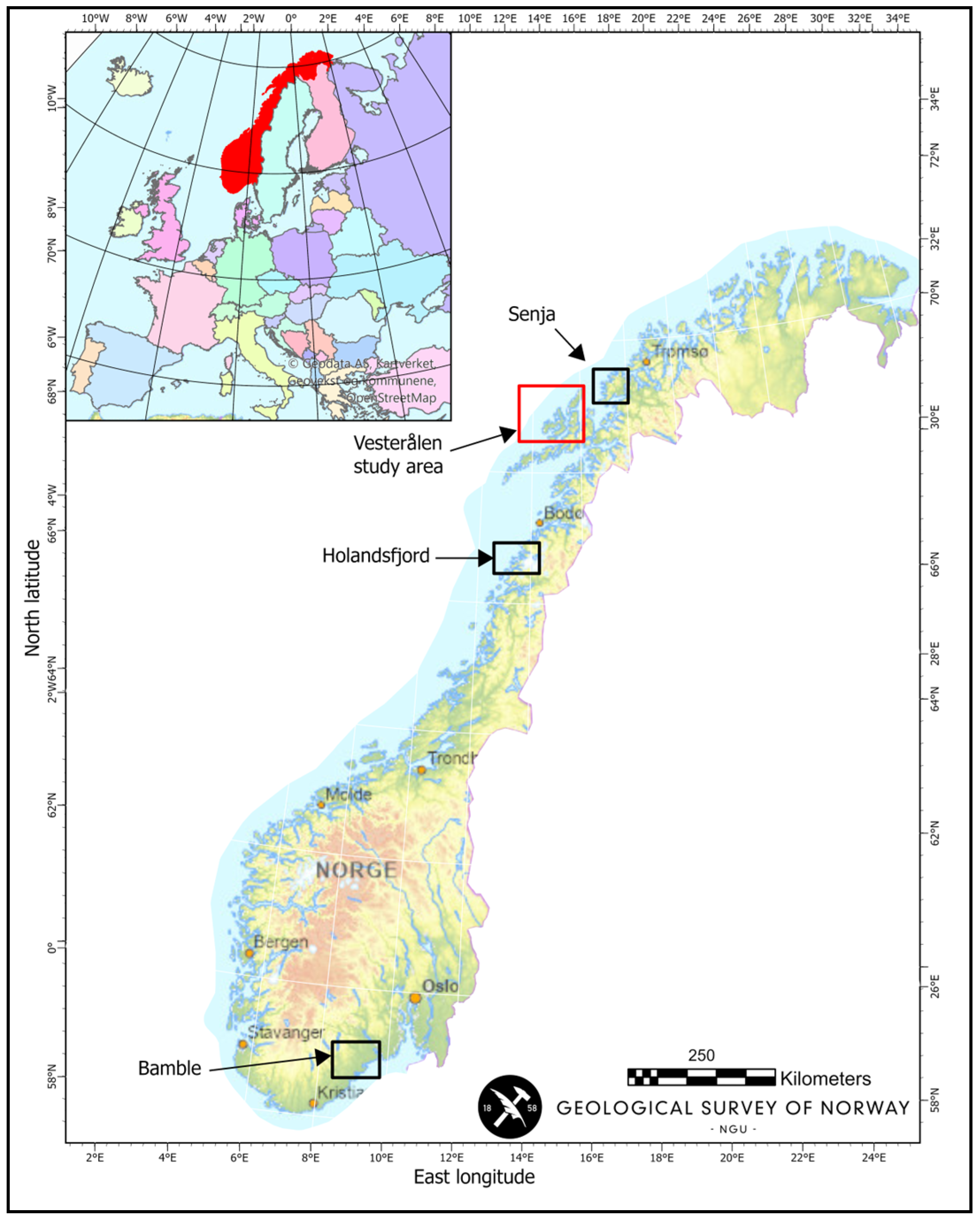
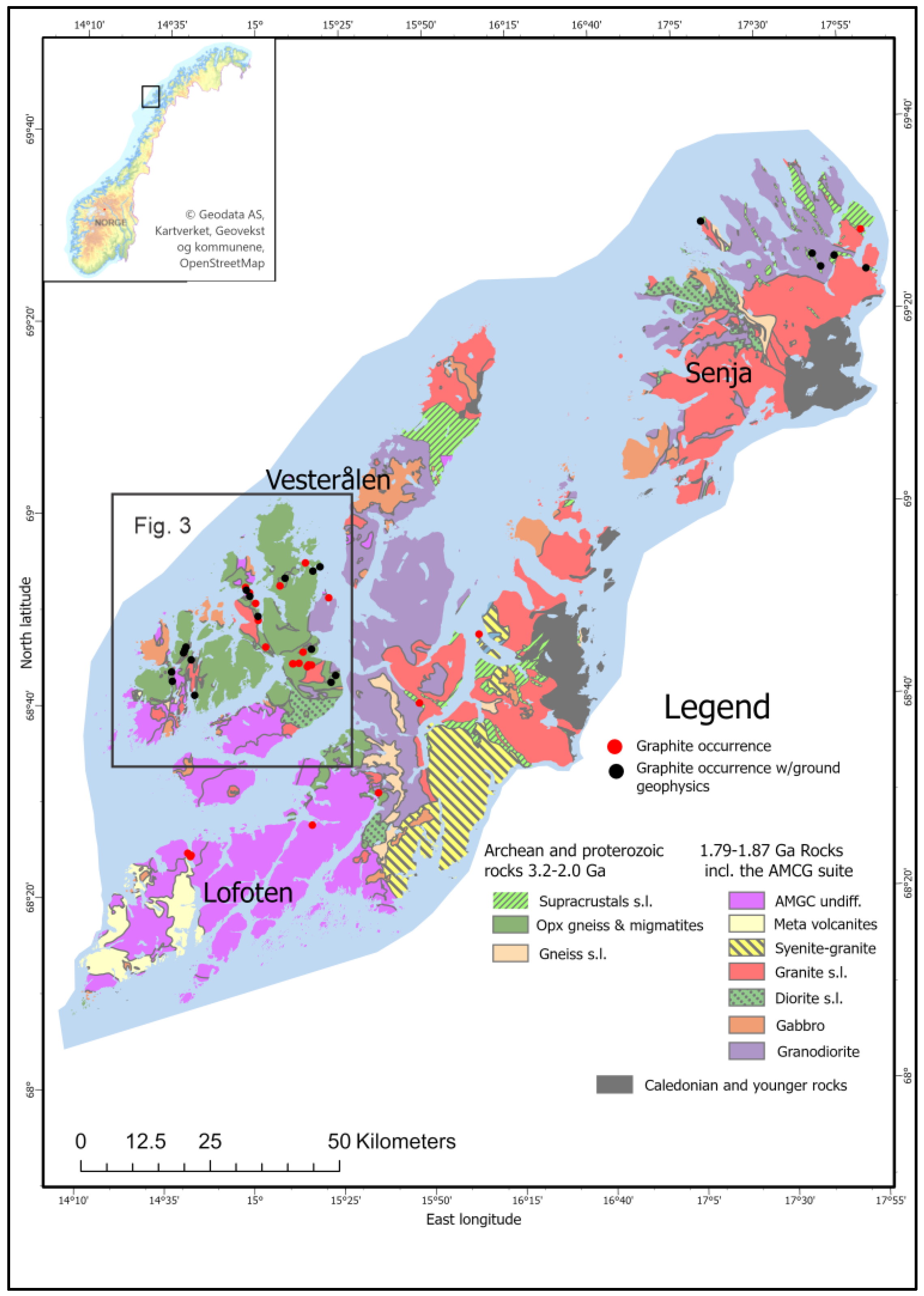
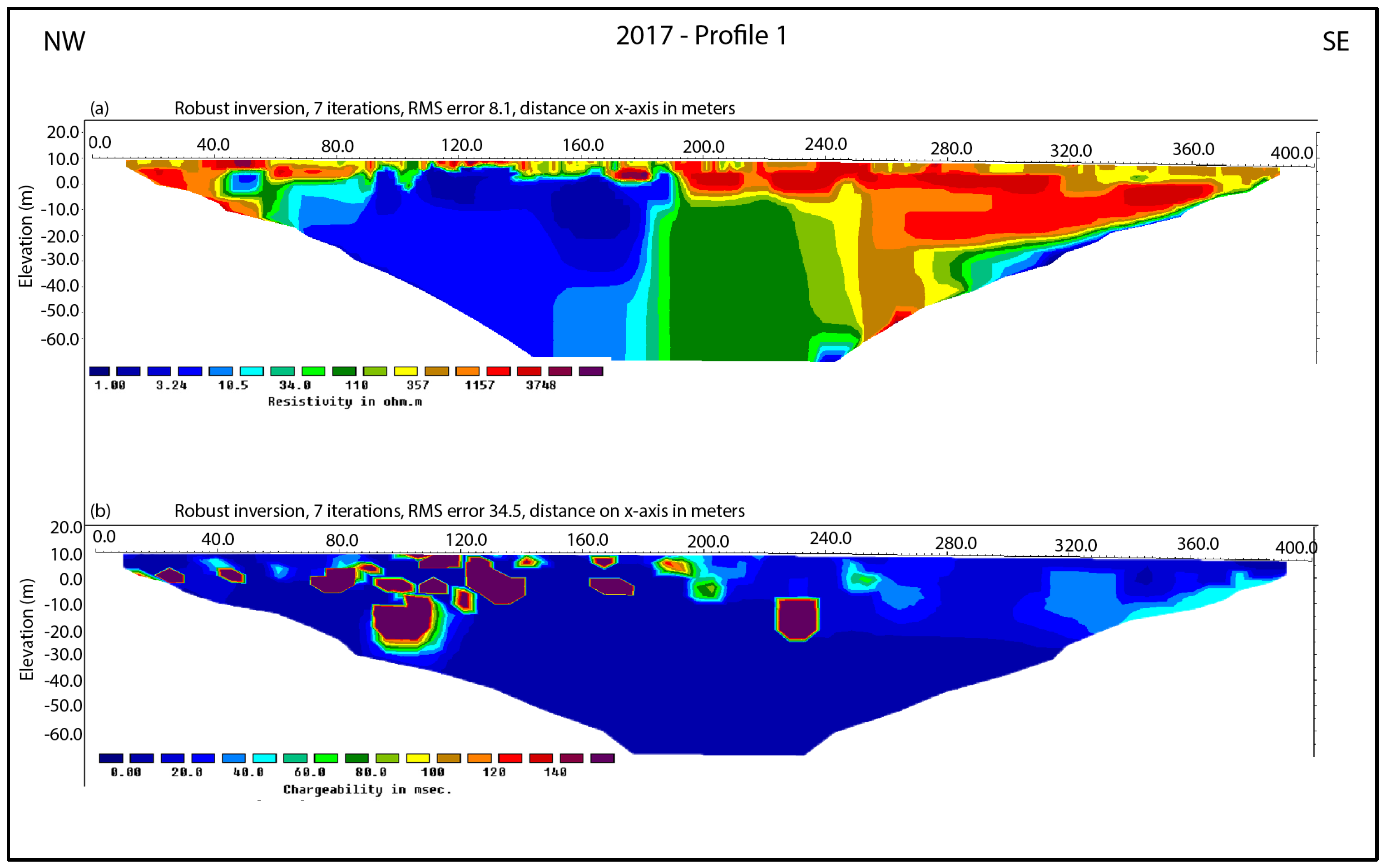

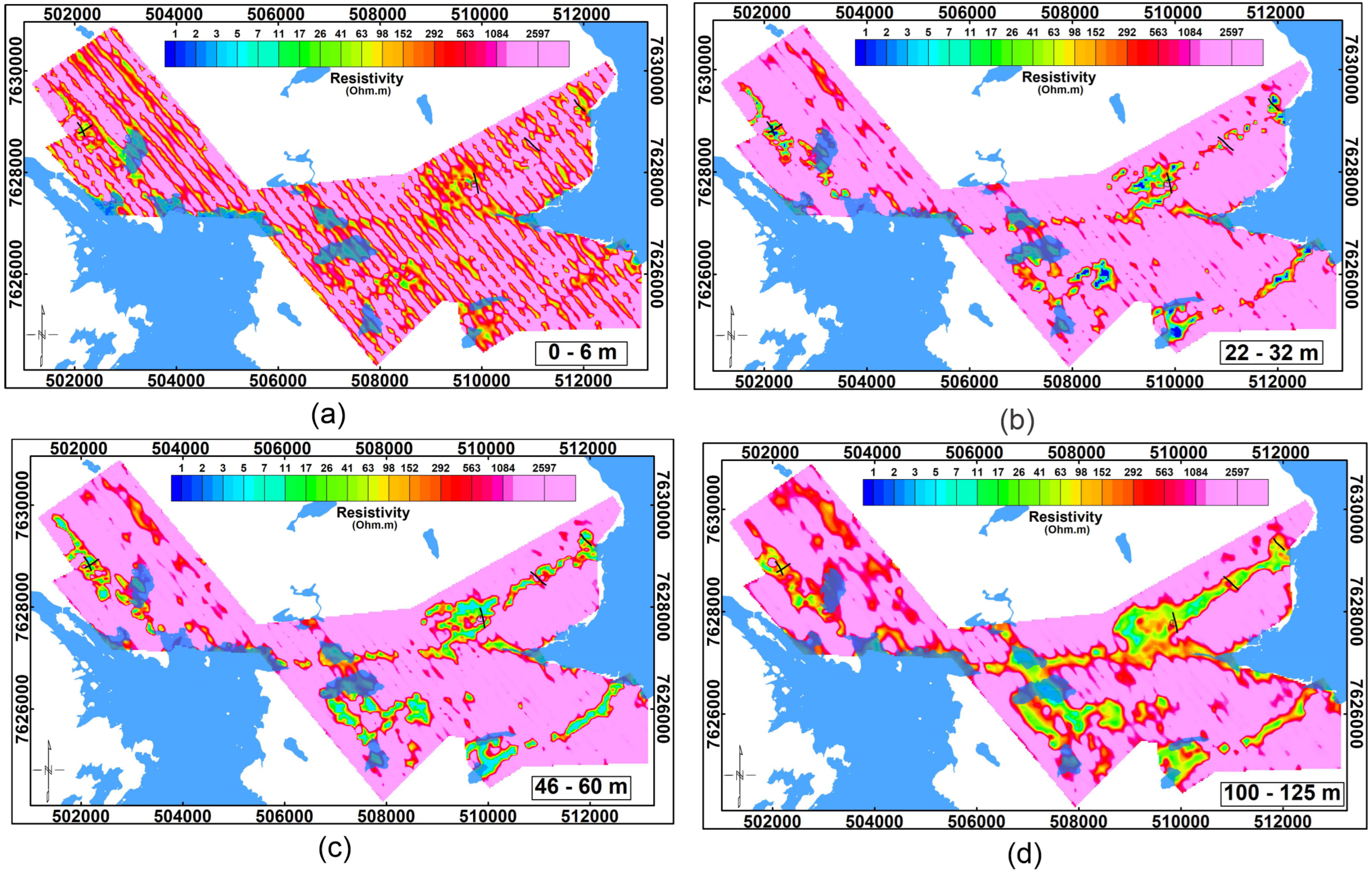
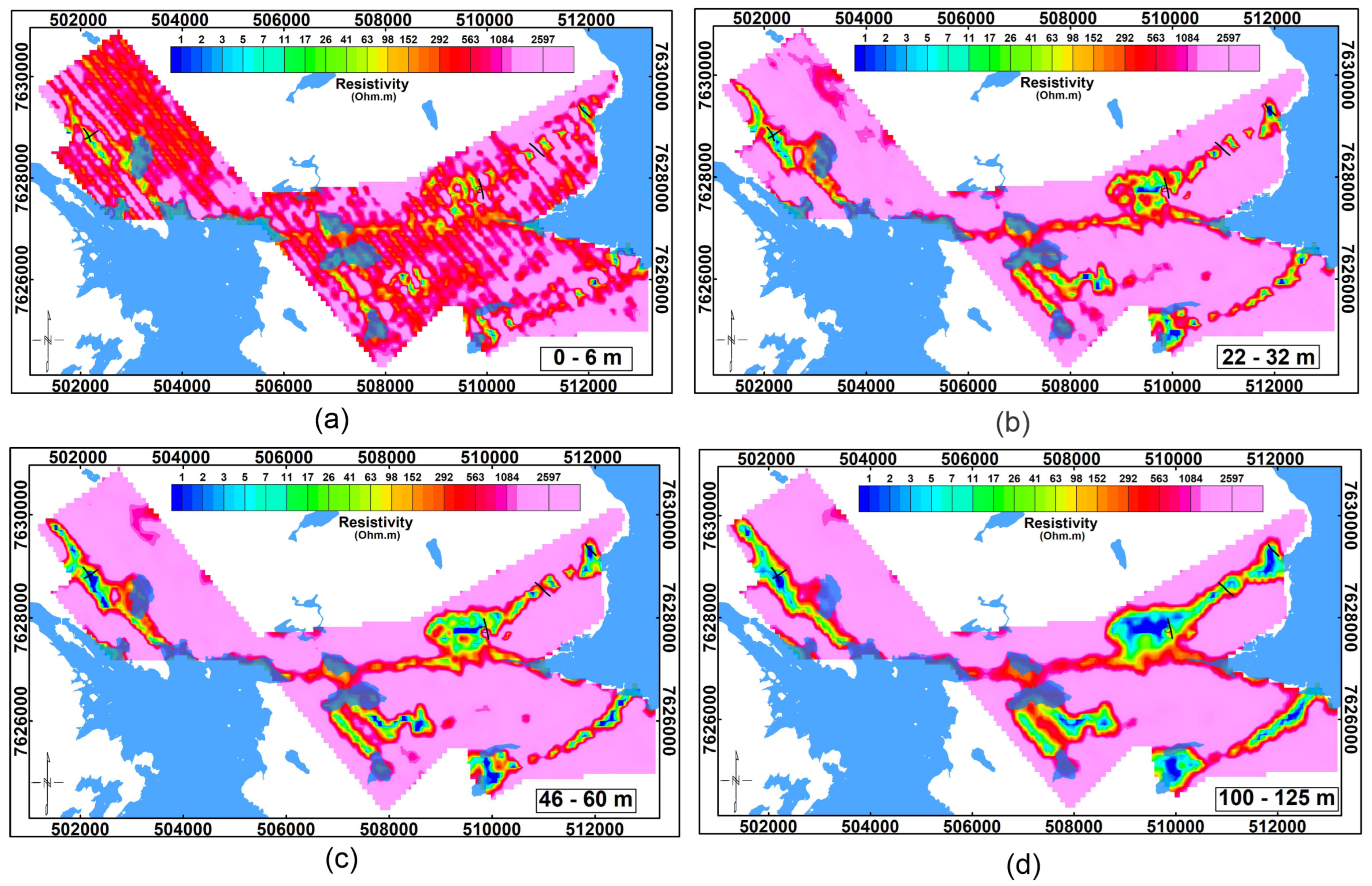
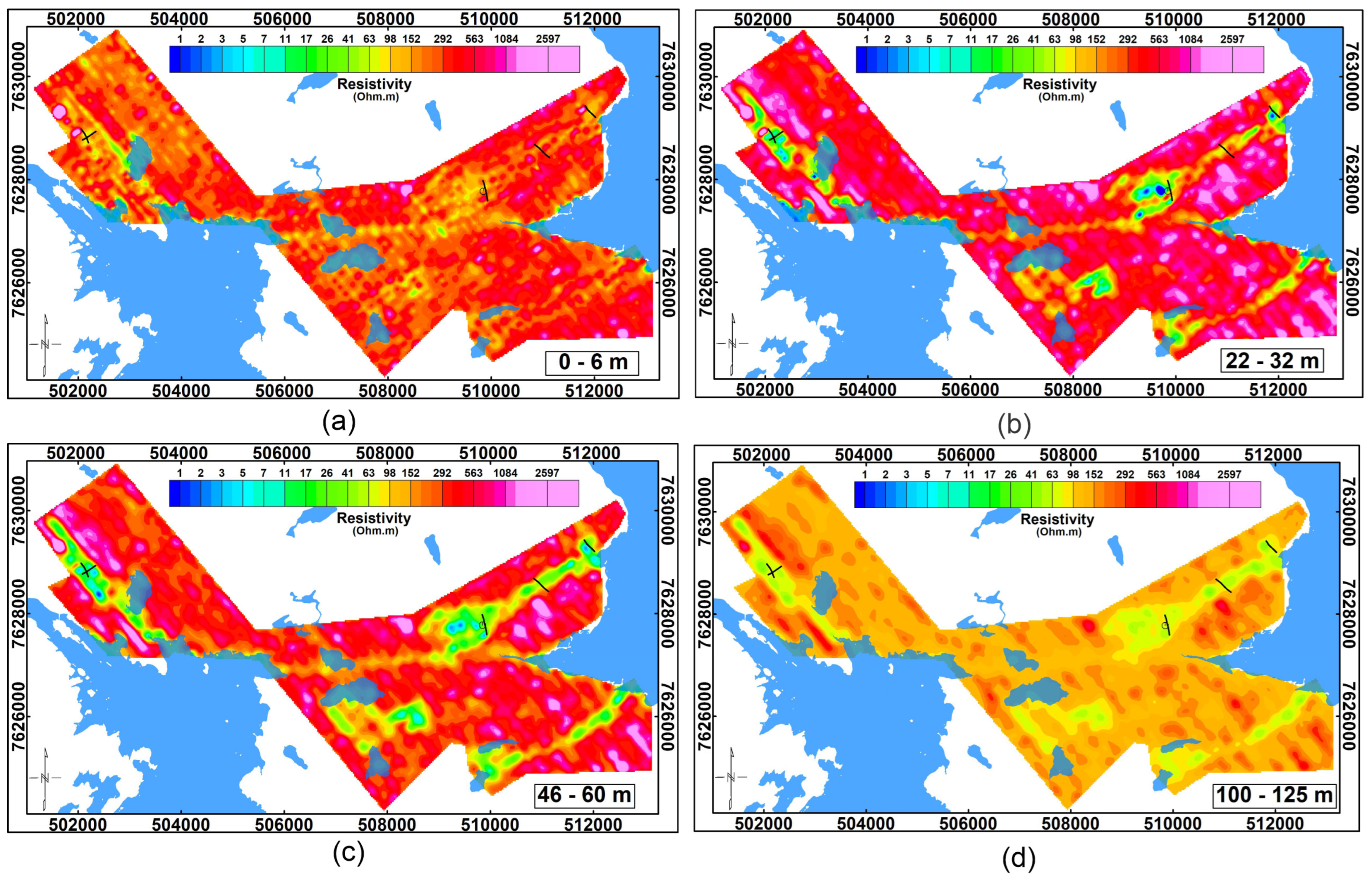



Disclaimer/Publisher’s Note: The statements, opinions and data contained in all publications are solely those of the individual author(s) and contributor(s) and not of MDPI and/or the editor(s). MDPI and/or the editor(s) disclaim responsibility for any injury to people or property resulting from any ideas, methods, instructions or products referred to in the content. |
© 2024 by the authors. Licensee MDPI, Basel, Switzerland. This article is an open access article distributed under the terms and conditions of the Creative Commons Attribution (CC BY) license (https://creativecommons.org/licenses/by/4.0/).
Share and Cite
Baranwal, V.C.; Rønning, J.S.; Larsen, B.E.; Su, Y.; Zhang, B.; Liu, Y.; Ren, X.; Gautneb, H.; Gellein, J. A Case History of Graphite Exploration in North Norway Integrating Various Geophysical Surveys. Minerals 2024, 14, 266. https://doi.org/10.3390/min14030266
Baranwal VC, Rønning JS, Larsen BE, Su Y, Zhang B, Liu Y, Ren X, Gautneb H, Gellein J. A Case History of Graphite Exploration in North Norway Integrating Various Geophysical Surveys. Minerals. 2024; 14(3):266. https://doi.org/10.3390/min14030266
Chicago/Turabian StyleBaranwal, Vikas Chand, Jan Steinar Rønning, Bjørn Eskil Larsen, Yang Su, Bo Zhang, Yunhe Liu, Xiuyan Ren, Håvard Gautneb, and Jomar Gellein. 2024. "A Case History of Graphite Exploration in North Norway Integrating Various Geophysical Surveys" Minerals 14, no. 3: 266. https://doi.org/10.3390/min14030266
APA StyleBaranwal, V. C., Rønning, J. S., Larsen, B. E., Su, Y., Zhang, B., Liu, Y., Ren, X., Gautneb, H., & Gellein, J. (2024). A Case History of Graphite Exploration in North Norway Integrating Various Geophysical Surveys. Minerals, 14(3), 266. https://doi.org/10.3390/min14030266








